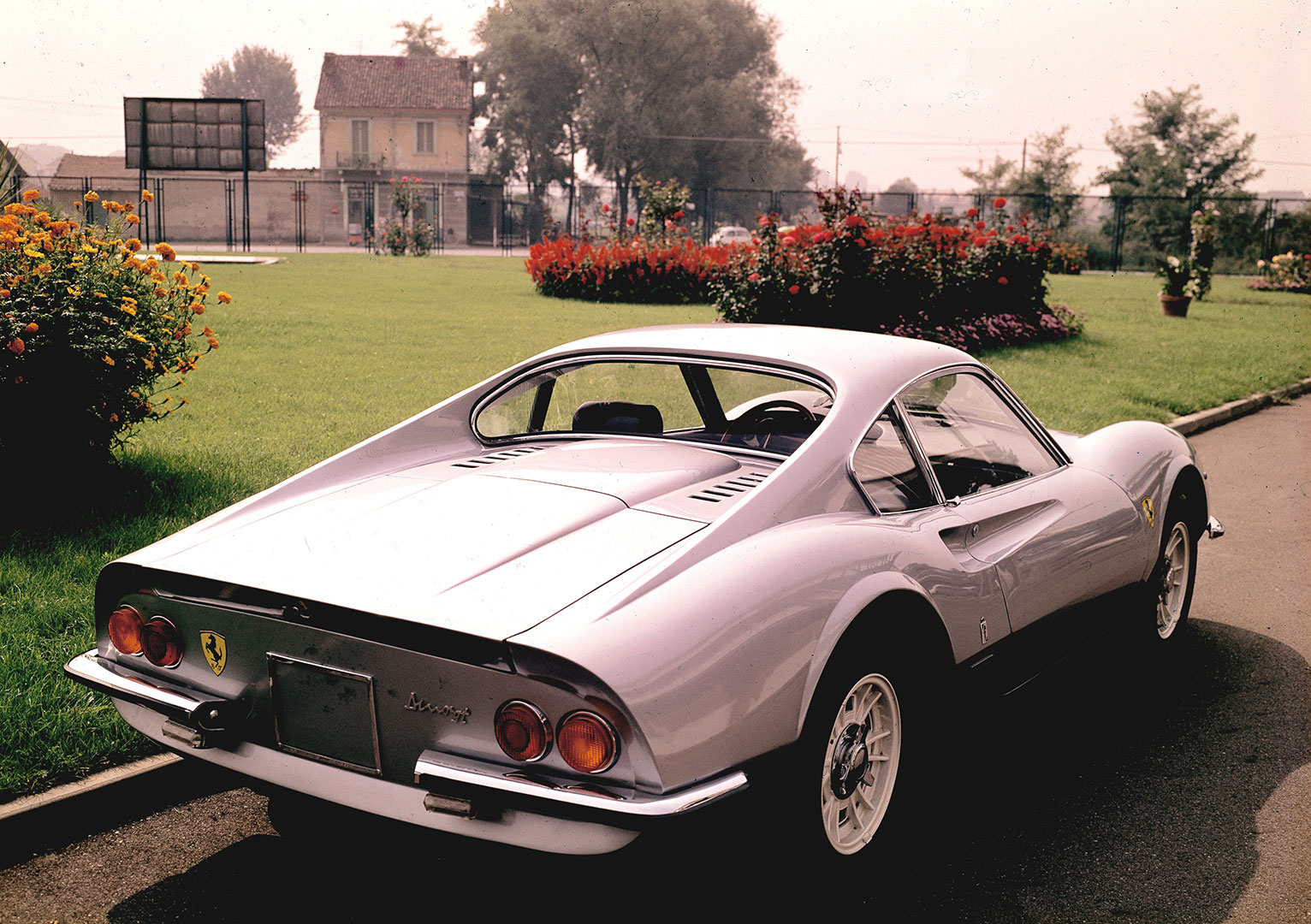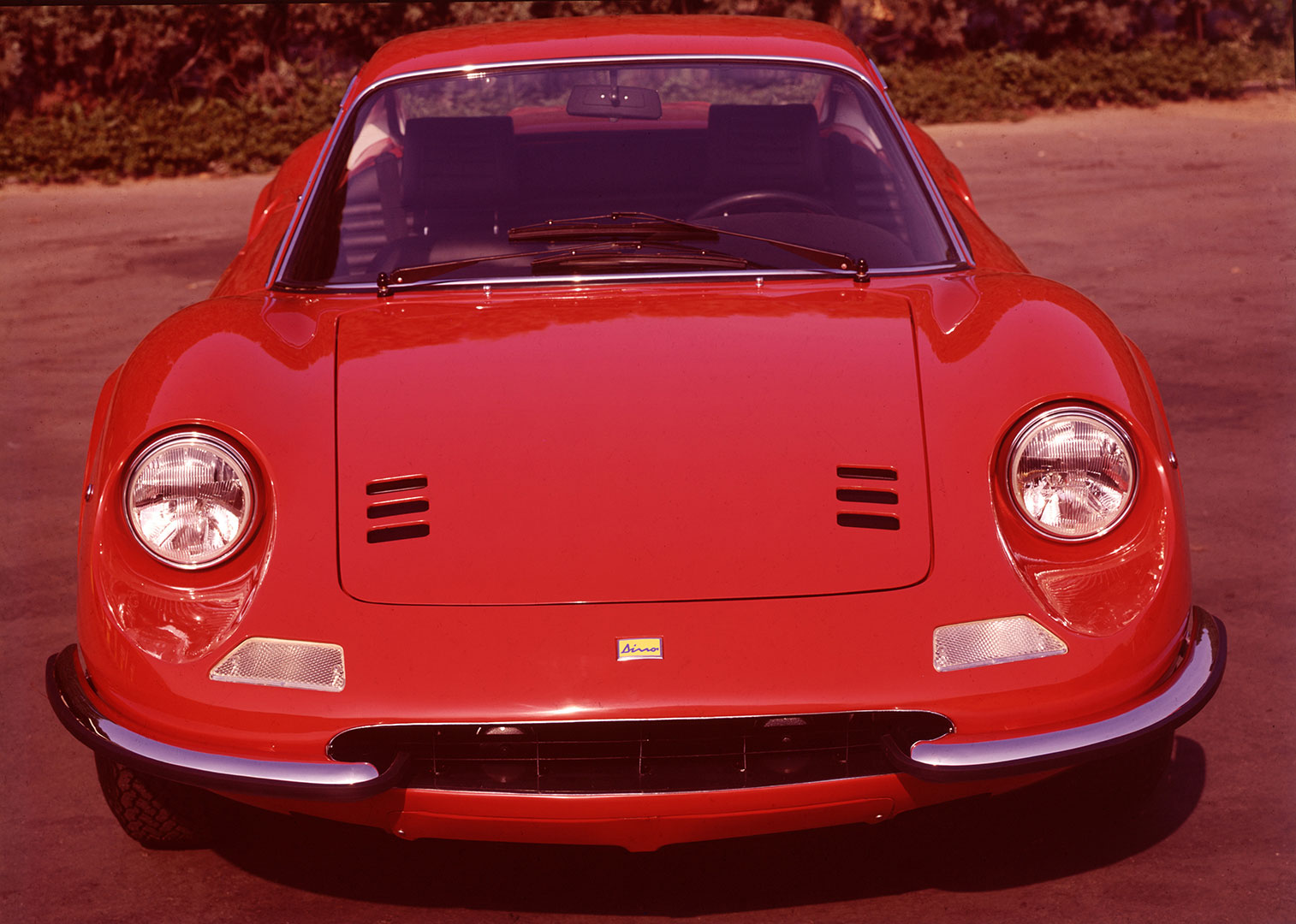?width=1920&height=1600)
Ferrari Dino 206 GT
For Ferrari it was becoming imperative to increase sales and reduce production costs. With the prototype of the Dino 196 S already in-house, there was an excellent opportunity to design a relatively small displacement, road-going version which, for the first time in Ferrari history, could be built on an assembly line. Pininfarina came up with pretty, classic lines and the Fiat V6 was developed by Ferrari and engineered for transverse mounting amidships.

The history
The model met some resistance amongst purists to begin with as it was not considered a ‘real’ Ferrari, but opinions soon changed once clients got the chance to see it close up and drive it. The small-engined Ferrari (relative to other models in the range at the time) came about due to regulations in Formula 2 monoposto racing for 1967, requiring that engines in racing cars had to be production-based, and produced in quantities of no fewer than 500 units a year. At the time, Ferrari could not hope to build that number of suitable units, so to enable them to compete, an alliance was forged with Fiat. Fiat would manufacture the engines and fit them into an upper market range of front-engined cars of their own, using the Dino name, and also supply engines to Ferrari for their own use.

All models, whether Fiat or Ferrari, would use the ‘Dino’ script badge. The Dino name was first used on Ferrari cars with vee engines in the late fifties, on Formula 1 and sports-racing models. It was the Christian name of the son of Enzo Ferrari, who had died in 1956, and was used in his memory as he was working on a vee-engine project prior to his death.
It continued to be used to designate any model with a vee engine throughout the early sixties, and then again in 1965 on the 166P mid-engined sports-racing model, which evolved into the 206 SP and 206 S sports-racing models. This was the first model to carry a Dino badge on the nose instead of a Ferrari one. The badge was a horizontal rectangle with his stylised script signature in blue on a yellow background. Later in 1965, at the Paris Salon, a mid-engined prototype was shown on the Pininfarina stand, called the ‘Dino 206 GT Speciale’, which was a design study for a road car, based on the chassis of a sports-racing model, with an in-line, mid-engined placement. It featured headlights under a clear perspex cover that extended the full width of the nose, but otherwise the shape was essentially that which would develop into the production road car.
The cabin featured a shallow, vertical concave curved rear screen between sail panel buttresses that ran into a Kamm tail. The prototype carried strong influences from the sports racing model, and the larger-engined Ferrari 412P, and 330 P4 sports-racers. This was particularly evident in the shape of the nose, with bulbous wings rolling down into a low front lid line, and the cabin sail panels sweeping down into a Kamm tail.


THE PROTOTYPE
From this first prototype followed another at the 1966 Turin Show, still with an in-line, mid-engined configuration. This featured an elliptical radiator opening with the headlights now wing-mounted under perspex covers. There was a higher roof to the cabin, carrying a similar rear screen and sail panel profile to the original, with quarter bumpers at each corner, showing the evolution from concept car to production model. By the time the next prototype appeared during 1967, the body was almost in its definitive form. The engine cover and boot lid were still one panel, and the strake in the door scallop had disappeared, fitted instead with door handles straight off the recently announced 365 GT 2+2, and alloy wheels that mirrored those fitted to the Fiat Dino. However, the most notable change was under the engine lid: the V6 had been turned through 90 degrees, to sit transversely, with a unitary 5-speed transmission assembly below and to the rear of it. The design, development, and manufacture of the transmission were all done in-house by Ferrari.
By the time of the Turin Show in November 1967, the fine tuning of the body detail had virtually been completed, and the example displayed was almost identical to the production cars that would follow. Noticeable differences from earlier prototypes were the two banks of triple radiator outlet slots on the front lid, with rows of matching engine bay exhaust slots on the engine lid, a steeper windscreen angle, and separate engine and boot lids. The same car was shown in January 1968 at the Brussels Salon, before being used for test purposes. The definitive production versions lost the clear, perspex headlight covers and gained quarter lights in the door glass. The simplest way to identify a 206 GT from its later sibling, the 246 GT, is by the exposed chrome-plated fuel filler cap on the left sail panel.

Production commenced during 1968 and ran into 1969, when the 2-litre engine was replaced by a 2.4-litre unit and, with other detail changes, the Dino 246 GT was born. During the nine-month production period, around 150 examples of the Dino 206 GT were built, all of which were left-hand drive. The production cars were built on a 2,280 mm wheel base chassis, constructed to familiar Ferrari principles of longitudinal main tubes, with cross bracing and sub frames to support various components and the body, with factory type reference number 607. A new even number chassis numbering sequence was adopted under the Dino brand name for these cars, to distinguish them from the odd number sequence of the Ferrari road cars of the time. The earlier prototypes had carried either Ferrari even competition series chassis numbers, or odd numbers in the road car sequence. Servo-assisted, ventilated disc brakes with independent suspension via wishbones, coil spring, and hydraulic shock absorber, were provided to each wheel, with front and rear anti-roll bars. The smooth, rounded body style – full curves of the front wings flowing into the cabin with its scalloped door panels, then into the curves of the rear wings and buttressed sail panels, terminating abruptly in a Kamm tail –drew universal praise. The shape is still widely regarded as a design classic. Unusually for the time, as most Ferrari models were built with steel bodies and aluminium opening panels, the Dino 206 GT had a full aluminium body. The tail panel carried a pair of circular lights at each side, also a feature of the 365 GTB4 ‘Daytona’, which was presented around the same time. Similarly, the two cars shared a very similar aluminium-faced, oval instrument panel that featured black-faced circular dials.


…almost a Ferrari
The engine was of a 65o configuration, with chain-driven, twin overhead camshafts per bank, having a total capacity of 1,987 cc, with a bore and stroke of 86 x 57 mm, bearing factory type reference 135B. The cylinder block was cast in Silumin alloy, with cast iron liners, whilst the cylinder heads and various other castings were of a similar alloy. The engine was transversely mounted in unit with the all-synchromesh, 5-speed transmission assembly below and to the rear of the engine’s wet sump.
It was fitted with a bank of three, twin choke Weber 40 DCN F/1 carburettors, mounted in the centre of the vee, with a distributor and electronic ignition system, to produce a claimed power output of 180 hp.
Although the Dino was promoted as a separate marque, the Ferrari heritage was not lost, as the sales brochure asserted: ‘Tiny, brilliant, safe…almost a Ferrari’.

- V6ENGINE
- 1986.60 ccTOTAL DISPLACEMENT
- 132 kWMAXIMUM POWER @ 8000 rpm
- 235 km/hTOP SPEED
- Typerear, transverse, 65° V6
- Bore/stroke86 x 57mm
- Unitary displacement331.10cc
- Total displacement1986.60cc
- Compression ratio9 : 1
- Maximum power132 kW (180 hp) at 8000 rpm
- Power per litre91hp/l
- Maximum torque-
- Valve actuationtwin overhead camshaft per bank, two valves per cylinder
- Fuel feedthree Weber 40 DCN F/1 carburettors
- Ignitionsingle spark plug per cylinder, single coil
- Lubricationwet sump
- Clutchsingle-plate
- Frametubular steel
- Front suspensionindependent, unequal-length wishbones, coil springs, telescopic shock absorbers, anti-roll bar
- Rear suspensionindependent, unequal-length wishbones, coil springs, telescopic shock absorbers, anti-roll bar
- Brakesdiscs
- Transmission5-speed + reverse
- Steeringrack-and-pinion
- Fuel tankcapacity 65litres
- Front tyres185 VR 14
- Rear tyres185 VR 14
- Typetwo-seater berlinetta
- Length4150mm
- Width1700mm
- Height1115mm
- Wheelbase2280mm
- Front track1425mm
- Rear track1400mm
- Weight900kg (dry)
- Top speed235km/h
- Acceleration 0-100 km/h-
- 0-400 m-
- 0-1000 m27 sec.
- history
- prototype
- engine
- Technical Details